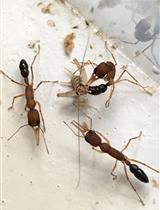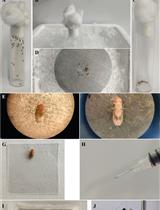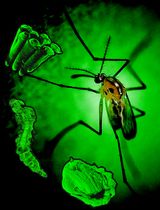- EN - English
- CN - 中文
Measuring Anxiety-like Behavior in Crayfish by Using a Sub Aquatic Dark-light Plus Maze
使用水下暗光十字迷宫法测试小龙虾的焦虑样行为
(*contributed equally to this work) 发布: 2015年02月05日第5卷第3期 DOI: 10.21769/BioProtoc.1396 浏览次数: 11989
评审: Arsalan DaudiSoyun KimAnonymous reviewer(s)
Abstract
Crayfish are omnivorous freshwater arthropods that naturally explore their environment during day and night, but also frequently hide under a shelter or in a hole in case of danger. They may be submitted to various stressors, including predation, social interactions or changes in environmental parameters (temperature, water quality, oxygen, etc.). It has been recently demonstrated that, as a consequence of stress, crayfish is able to adapt its exploratory behavior by restricting movements to protective areas, a response similar to the anxiety-like behavior (ALB) observed in rodents. To reveal such a behavior in an aquatic species, we designed a plus-shaped sub aquatic maze divided in two protective dark arms and two more aversive illuminated arms. The aim of this paradigm was to place crayfish in a conflicting situation between its innate curiosity for novel environment and its aversion for light (Leo, 2014; Pellow et al., 1985). Unstressed crayfish generally explore the whole maze, including illuminated arms. By contrast stressed crayfish remain preferentially in the dark arms (Fossat et al., 2014). Stressed crayfish injected with anxiolitics (chlordiazepoxide-CDZ), behave as unstressed animals. Several parameters, related to the light arms can be easily measured from video records by commercial software This protocol could be suitable for analyzing the effects of any stressful situation on ALB in crayfish, as well as in many other aquatic species.
Materials and Reagents
- Animals
- The study has been performed on adult male crayfish, Procambarus clarkii , fished near Bordeaux (France) in the "Réserve naturelle de Bruges" and stored in an animal house with 12:12 dark light cycle. Crayfish were fed ad libitum with pellets (Novo Prawn). Crayfish used for this study were 8.7 ± 0.8 cm and 22.1 ± 1.1 g. We generally used male crayfish in our experiments (distinguished by their first abdominal appendages), but this protocol is also suitable for experiments on females.
- Before any experiment, crayfish were isolated in enriched aquariums (75 cm x 40 cm x 50 cm), filled with recycled oxygenated water and enriched with pebbles and plastic tubes (behind or inside which they can hide). Animals were kept isolated at least 3 weeks before any experiment in order to erase past life histories and to avoid social interactions.
- Water must be chlorine free (agitating fresh tap water during 24 h is generally enough to remove chlorine). Change water after each session or use a conventional filtering system for aquarium.
- Fishnets are used to manipulate crayfish.
- The study has been performed on adult male crayfish, Procambarus clarkii , fished near Bordeaux (France) in the "Réserve naturelle de Bruges" and stored in an animal house with 12:12 dark light cycle. Crayfish were fed ad libitum with pellets (Novo Prawn). Crayfish used for this study were 8.7 ± 0.8 cm and 22.1 ± 1.1 g. We generally used male crayfish in our experiments (distinguished by their first abdominal appendages), but this protocol is also suitable for experiments on females.
- Reagents
- Ringer: Crayfish were injected with a classical invertebrate ringer containing 195 NaCl, 5 KCl, 13 CaCl2, 2 MgCl2 and 3 HEPES (Sigma-Aldrich) with a pH of 7.65
- Chlordiazepoxide hydrochloride (CDZ) (Sigma-Aldrich) (dissolved in crayfish ringer and was used at a dose 15 µg/g)
- Ringer: Crayfish were injected with a classical invertebrate ringer containing 195 NaCl, 5 KCl, 13 CaCl2, 2 MgCl2 and 3 HEPES (Sigma-Aldrich) with a pH of 7.65
Equipment
- Dark/light (D/L) plus maze
- Customized apparatus (65 x 65 cm, see Figure 1) is adapted to the size of adult crayfish. Smaller or larger dimensions might be necessary for young crayfish or other species.
- The illuminated arms were made of transparent Plexiglas and dark arms of opaque Plexiglas (Figure 1).
- The maze is filled with ca. 7 cm of oxygenated freshwater. It is placed in the center of a larger round tank (Figure 2). The round tank (1.5 m in diameter) is also filled with 7 cm freshwater to equilibrate water pressure on each maze wall and to allow for good oxygenation and recycling of water (Figure 2).
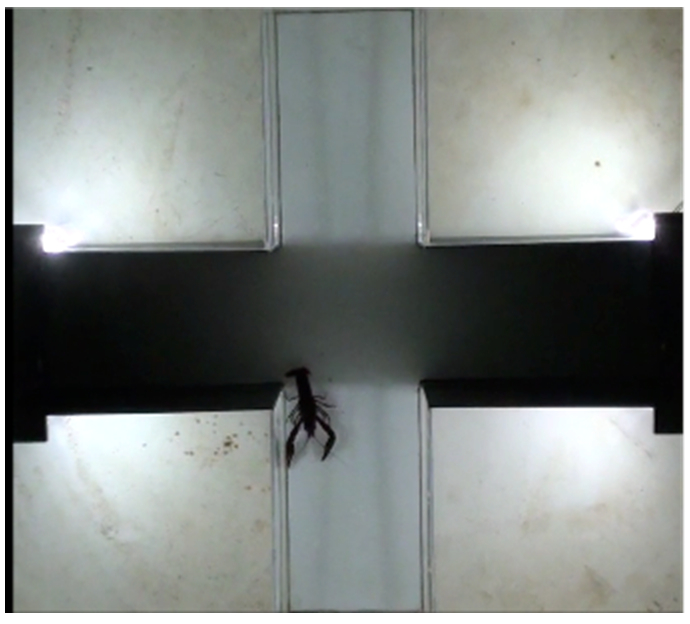
Figure 1. Dark/light plus maze. The total length of the maze is 65 cm x 65 cm. Each arm is 25 cm long and 15 cm wide. The middle zone is 15 cm x 15 cm. The light is generated by four sources comprising two LEDs. Each source of light is placed on the outside face of the opaque Plexiglas.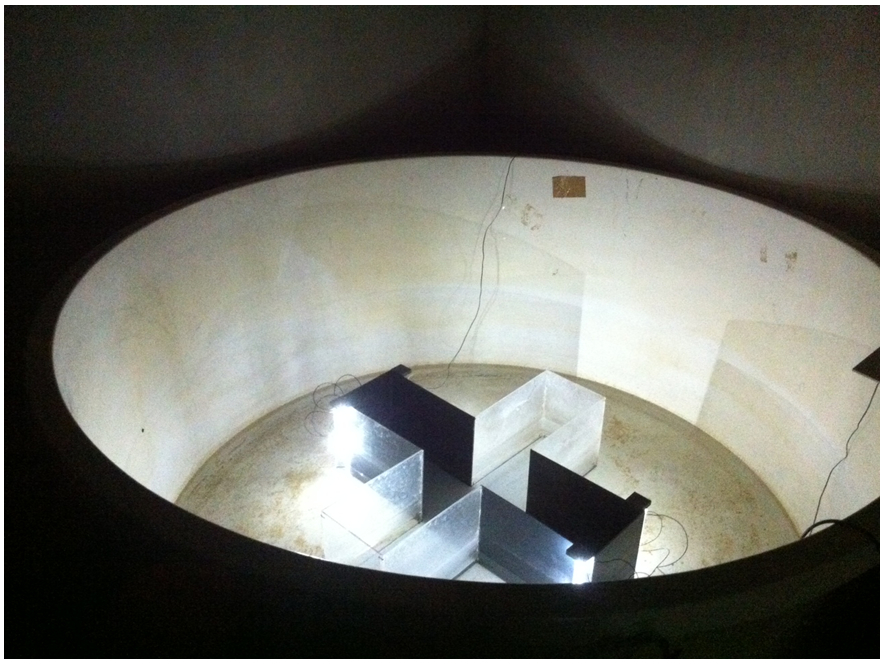
Figure 2. The dark/light plus maze is placed in a larger tank (diameter 1.5 m). Right: Room light switch on. Left: Room light switch off under experimental conditions. - Illumination of the light arms is performed by a series of LEDs (white light; voltage; 3.5 V, light intensity; 880 to 2,530 mcd) disposed outside the plus maze, on the outward side of the dark arms on the outmost extremities (see Figure 3).
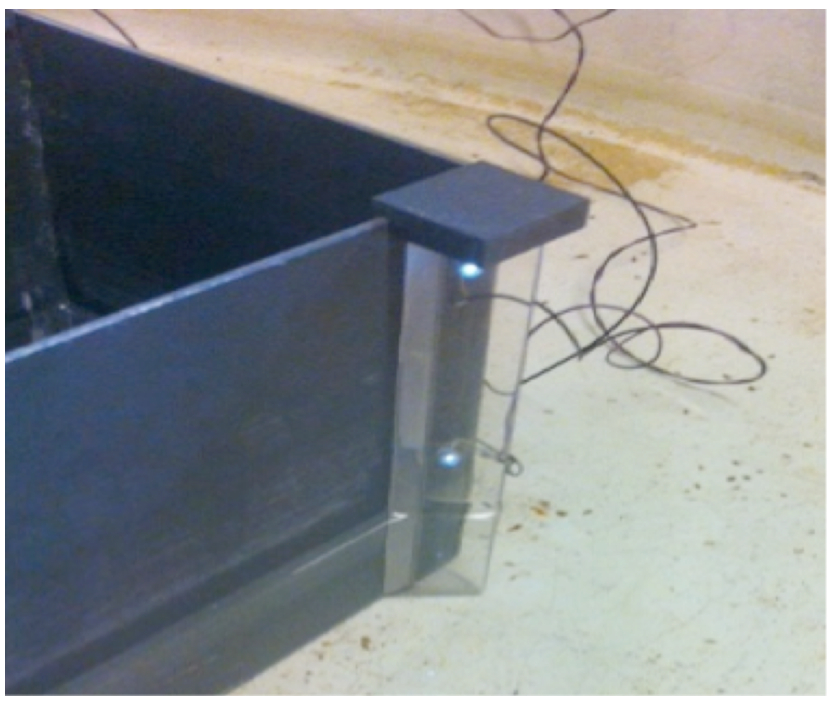
Figure 3. Two LEDs placed at the end of the dark arm illuminate a light arm. The height of the maze wall is 20 cm.
- Customized apparatus (65 x 65 cm, see Figure 1) is adapted to the size of adult crayfish. Smaller or larger dimensions might be necessary for young crayfish or other species.
- Other devices
- A video camera must be placed above the maze. We used a handycam (Sony inc, model: HDR-XR155) but any commercial camera can be used.
- A pump (NewJet) is placed on a large tank between experimental sessions to agitate and oxygenate water.
- Light intensity was assessed with a luxmeter (Chauvin Arnoux).
- A video camera must be placed above the maze. We used a handycam (Sony inc, model: HDR-XR155) but any commercial camera can be used.
Software
- We used Ethovision v8 (Noldus) but any tracking software can be used. Measured parameters are listed in Table 1.
Table 1. List of parameters that can be used to analyse the anxiety-like behaviour in the D/L plus mazeName of variable (and abbreviation used in Figure 2) Definition Measurement Range Total distance moved (Distance) Distance moved in the entire arena. cm ≥0 % Time in zone (%T light, dark) Time spent in a zone (dark or light)/(divided by total time)*100 % 0-100 Latency to first in light (Lat.Light) Time from start time to first entry in a light arm Second (s) 0-600 Latency to first in dark (Lat.Dark) Time from start time to first entry in a dark arm Second (s) 0-600 Mean number of entry in light arms (Nb. ent. Dark) Number of entry from middle zone to a light arm NA ≥0 Mean number of entry in dark arms (Nb. ent. Light) Number of entry from middle zone to a dark arm NA ≥0 Mean duration per visit in light arms Time in light arms/mean number of entry Second (s) ≥0 Mean duration per visit in dark arms Time in dark arms/mean number of entry Second (s) ≥0 Retreat Ratio (RR) Number of retreat / total number of attempts NA 0-1
Procedure
文章信息
版权信息
© 2015 The Authors; exclusive licensee Bio-protocol LLC.
如何引用
Fossat, P., Bacqué-Cazenave, J., Delbecque, J. and Cattaert, D. (2015). Measuring Anxiety-like Behavior in Crayfish by Using a Sub Aquatic Dark-light Plus Maze. Bio-protocol 5(3): e1396. DOI: 10.21769/BioProtoc.1396.
分类
神经科学 > 行为神经科学 > 实验动物模型
神经科学 > 行为神经科学 > 学习和记忆
您对这篇实验方法有问题吗?
在此处发布您的问题,我们将邀请本文作者来回答。同时,我们会将您的问题发布到Bio-protocol Exchange,以便寻求社区成员的帮助。
Share
Bluesky
X
Copy link










